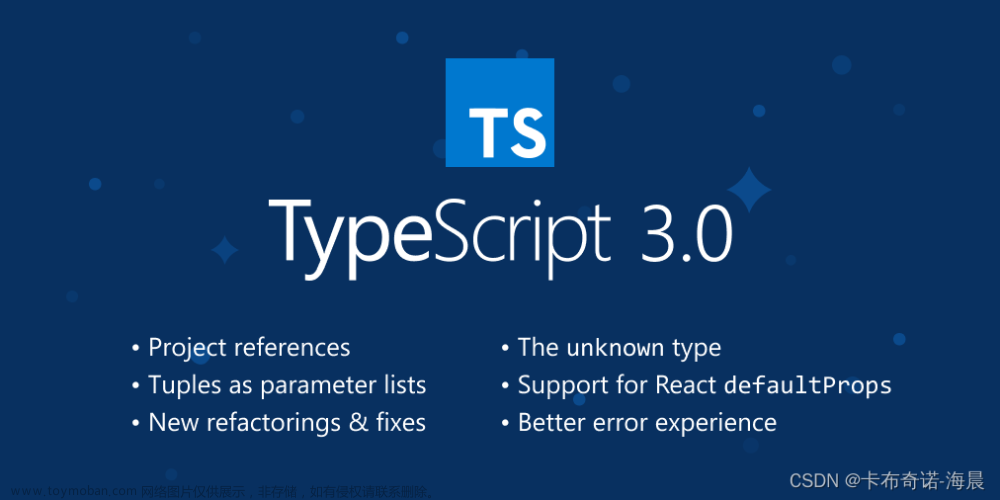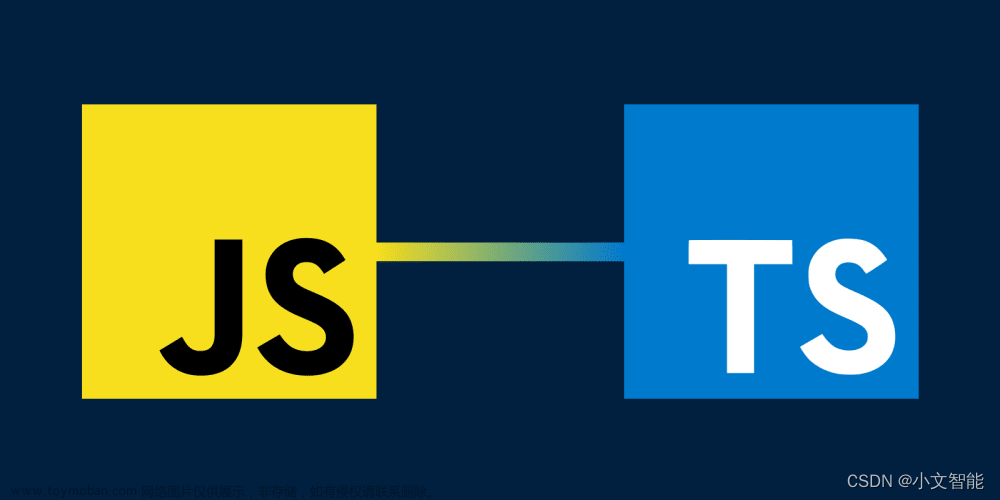
系列文章目录
TypeScript 从入门到进阶系列
- TypeScript 从入门到进阶之基础篇(一) ts基础类型篇
- TypeScript 从入门到进阶之基础篇(二) ts进阶类型篇
- TypeScript 从入门到进阶之基础篇(三) 元组类型篇
- TypeScript 从入门到进阶之基础篇(四) symbol类型篇
- TypeScript 从入门到进阶之基础篇(五) 枚举类型篇
- TypeScript 从入门到进阶之基础篇(六) 类型(断言 、推论、别名)| 联合类型 | 交叉类型 篇
- TypeScript 从入门到进阶之基础篇(七)泛型篇
- TypeScript 从入门到进阶之基础篇(八)函数篇
-
TypeScript 从入门到进阶之基础篇(九) Class类篇
持续更新中…
前言
TypeScript抽象类是一种用于定义其他类的基础类,它不能直接被实例化,只能被继承。抽象类可以包含属性、方法、以及其他抽象方法的定义。抽象方法只有定义而没有具体实现,需要在具体的子类中实现。
一、抽象类(abstract)的使用
抽象类通过使用关键字 abstract 来定义,而抽象方法通过在方法前加上关键字 abstract 来定义。抽象类和抽象方法用于定义类的行为和结构,并且可以提供一些通用的实现或规范,以供子类继承和实现。
抽象类在面向对象编程中有以下特点:
- 不能直接实例化:抽象类
不能被直接实例化,只能被继承后使用。 - 可以包含属性和方法:抽象类中
可以定义属性和方法,可以有具体实现的方法和抽象方法。 - 可以包含抽象方法:抽象类中
可以定义抽象方法,这些方法只有方法的声明而没有具体实现,需要在具体的子类中实现。 - 子类必须实现抽象方法:当一个类继承了抽象类时,它必须实现抽象类中的所有抽象方法。
下面是一个使用抽象类的例子:
//抽象类
abstract class Animal {
name: string;
constructor(name: string) {
this.name = name;
}
//抽象方法 只能有方法的声明而没有具体实现
//要实现只能在继承此类之后去实现
abstract makeSound(): void;
move(distance: number = 0) {
console.log(`${this.name} moved ${distance}m`);
}
}
//Dog 继承 Animal 抽象类
class Dog extends Animal {
constructor(name: string) {
super(name);
}
//将Animal 抽象类中的 抽象方法 进行实例化
makeSound() {
console.log(`${this.name} barks`);
}
}
let dog = new Dog('Buddy');
dog.makeSound(); // 输出: "Buddy barks"
dog.move(10); // 输出: "Buddy moved 10m"
在这个例子中,Animal 类是一个抽象类,它有一个抽象方法 makeSound 和一个实现方法 move。Dog 类继承了 Animal 类,并实现了 makeSound 方法。
你不能直接实例化抽象类,但可以通过继承抽象类的方式创建实例。在这个例子中,我们创建了一个名为 dog 的 Dog 类的实例,并调用了它的 makeSound 和 move 方法。
二、抽象类(abstract)的使用场景
TypeScript抽象类的使用场景:
- 抽象类可以被用作基类,它提供了一个通用的模板或蓝图,用于派生出其他类。
- 抽象类可以定义抽象方法,这些方法在派生类中必须被实现。这样可以确保派生类具有某些特定的功能或行为。
- 抽象类可以实现一些通用的功能,而不用在每个派生类中重新实现这些功能。这样可以使代码更加可维护和可扩展。
- 抽象类可以用于限制实例化。它们不能直接被实例化,只能被用作继承。
- 抽象类可以定义属性和方法,这些属性和方法可以被派生类继承和重写。
总之,抽象类在需要定义一个通用模板或蓝图,并确保派生类具有某些特定功能或行为的情况下非常有用。它们可以提供代码重用、可维护性和可扩展性。
一个常见的应用场景案例是在Web应用开发中使用抽象类来建模和组织组件。
假设我们正在开发一个在线购物应用,其中有多种类型的商品,例如电子产品、服装和食品。我们可以使用抽象类来定义一个通用的商品类,并为每种具体类型的商品创建一个子类。
首先,我们定义一个抽象商品类:
abstract class Product {
protected name: string;
protected price: number;
constructor(name: string, price: number) {
this.name = name;
this.price = price;
}
abstract getDescription(): string;
}
然后,我们创建几个具体类型的商品类:
class Electronics extends Product {
protected brand: string;
constructor(name: string, price: number, brand: string) {
super(name, price);
this.brand = brand;
}
getDescription(): string {
return `This ${this.brand} ${this.name} costs $${this.price}`;
}
}
class Clothing extends Product {
protected size: string;
constructor(name: string, price: number, size: string) {
super(name, price);
this.size = size;
}
getDescription(): string {
return `This ${this.size} ${this.name} costs $${this.price}`;
}
}
class Food extends Product {
protected expirationDate: string;
constructor(name: string, price: number, expirationDate: string) {
super(name, price);
this.expirationDate = expirationDate;
}
getDescription(): string {
return `This ${this.name} expires on ${this.expirationDate}`;
}
}
现在,我们可以使用这些具体类型的商品类创建实例,并调用它们的getDescription方法来获取商品的描述:文章来源:https://www.toymoban.com/news/detail-796048.html
const iphone = new Electronics('iPhone', 999, 'Apple');
console.log(iphone.getDescription()); // 输出: This Apple iPhone costs $999
const shirt = new Clothing('T-Shirt', 29, 'M');
console.log(shirt.getDescription()); // 输出: This M T-Shirt costs $29
const milk = new Food('Milk', 2.99, '2022-01-31');
console.log(milk.getDescription()); // 输出: This Milk expires on 2022-01-31
这个例子中,抽象类Product定义了一个共享的属性和方法,而具体的商品类继承了这些属性和方法,并根据自己的特性实现了getDescription方法。一个常见的应用场景案例是在Web应用开发中使用抽象类来建模和组织组件。
假设我们正在开发一个在线购物应用,其中有多种类型的商品,例如电子产品、服装和食品。我们可以使用抽象类来定义一个通用的商品类,并为每种具体类型的商品创建一个子类。
首先,我们定义一个抽象商品类:
abstract class Product {
protected name: string;
protected price: number;
constructor(name: string, price: number) {
this.name = name;
this.price = price;
}
abstract getDescription(): string;
}
然后,我们创建几个具体类型的商品类:
class Electronics extends Product {
protected brand: string;
constructor(name: string, price: number, brand: string) {
super(name, price);
this.brand = brand;
}
getDescription(): string {
return `This ${this.brand} ${this.name} costs $${this.price}`;
}
}
class Clothing extends Product {
protected size: string;
constructor(name: string, price: number, size: string) {
super(name, price);
this.size = size;
}
getDescription(): string {
return `This ${this.size} ${this.name} costs $${this.price}`;
}
}
class Food extends Product {
protected expirationDate: string;
constructor(name: string, price: number, expirationDate: string) {
super(name, price);
this.expirationDate = expirationDate;
}
getDescription(): string {
return `This ${this.name} expires on ${this.expirationDate}`;
}
}
现在,我们可以使用这些具体类型的商品类创建实例,并调用它们的getDescription方法来获取商品的描述:
const iphone = new Electronics('iPhone', 999, 'Apple');
console.log(iphone.getDescription()); // 输出: This Apple iPhone costs $999
const shirt = new Clothing('T-Shirt', 29, 'M');
console.log(shirt.getDescription()); // 输出: This M T-Shirt costs $29
const milk = new Food('Milk', 2.99, '2022-01-31');
console.log(milk.getDescription()); // 输出: This Milk expires on 2022-01-31
这个例子中,抽象类Product定义了一个共享的属性和方法,而具体的商品类继承了这些属性和方法,并根据自己的特性实现了getDescription方法。文章来源地址https://www.toymoban.com/news/detail-796048.html
到了这里,关于TypeScript 从入门到进阶之基础篇(十) 抽象类篇的文章就介绍完了。如果您还想了解更多内容,请在右上角搜索TOY模板网以前的文章或继续浏览下面的相关文章,希望大家以后多多支持TOY模板网!











